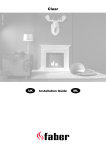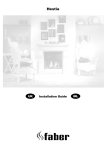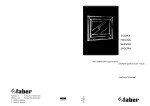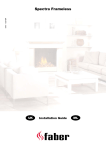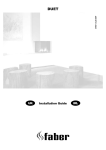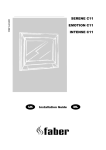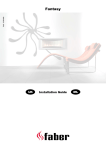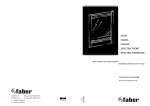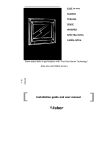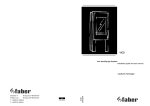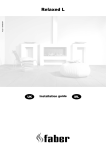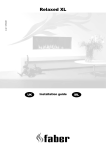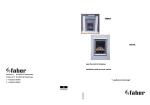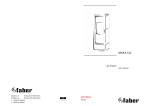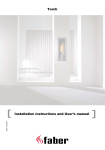Download Honest
Transcript
Honest 40010569 - 0821 UK Installationguide IRL UK IRL General Bolt & Nut Rough adjustment Fine adjustment 1-1 1-2 1-3 1-4 Keep at least 10 mm between 1-5 1<<<< 1-6 UK IRL Placing the log set 2-1 2-2 2-3 2-4 >>>>2 UK IRL Placing the glass 3<<<< 3-1 3-2 3-3 3-4 3-5 3-6 UK IRL Content 1 Introduction ......................................................................................... 5 2 Safety and general information .................................................................. 6 3 Installation requirements ......................................................................... 7 4 5 3.1 Builders opening.............................................................................. 7 3.2 Flue requirements............................................................................ 7 Instruction for Installation ........................................................................ 9 4.1 Gas connection ............................................................................... 9 4.2 Preparing the appliance..................................................................... 9 4.3 Placing the appliance........................................................................ 9 4.4 Building the surround....................................................................... 10 4.5 Placing the log set .......................................................................... 10 4.6 Placing the glass............................................................................. 10 Commissioning (functional checks) ............................................................. 11 5.1 Pilot ignition check ......................................................................... 11 5.2 Check functional burner and pilot burner............................................... 11 6 Handing over (final check and customer briefing) ........................................... 12 7 Servicing ............................................................................................ 12 7.1 Routine anual servicing .................................................................... 12 7.2 Cleaning the combustion chamber and burner ......................................... 13 7.3 Rebuild to other gas category (e.g. Propane/butane) ............................... 13 Appendix A: Example calculation..................................................................... 14 Appendix B: Flue restrictor............................................................................ 15 Appendix C: Installation of the flue.................................................................. 16 Appendix D: Technical specifications ................................................................ 18 Appendix E: Dimensions................................................................................ 19 >>>>4 UK IRL 1 Introduction Note: these instructions should be read carefully and retained for future reference. Please leave these instructions with the user. Special features: • Realistic flame pattern by use of the patented Log burner technology • Room sealed appliance, inlet and outlet are led to the outside using a natural draught concentric pipe system (100 mm/150 mm) (no power fan required) • Air supply and flue-gases go to outside atmosphere through wall or roof • Remote Control standard • Meets the requirements of the European Gas Appliance Directive (GAD) and carries the CE mark 5<<<< UK IRL 2 Safety and general information Before installation, ensure that the local distribution conditions (identification of the type of gas and pressure) and the adjustment of the appliance are compatible. This gas appliance is factory set and can not be adjusted. This appliance does not contain any component manufactured from asbestos or any asbestos related products. Ventilation This appliance is room-sealed and doesn't require purpose provided ventilation. Never use the appliance if it has a broken glass. General safety It is the law in the UK that all gas appliances, are installed by a competent person in accordance with the Gas Safety (Installation and Use) Regulations (as amended), the relevant British Standards for Installation work, Building Regulations, Codes of Practice and the manufacturers instructions. Always use an additional guard if there are elderly, infirm or children in the same room of the appliance. The installation should also be carried out in accordance with the following where relevant: • BS5871 Part1 • BS5440 Parts 1 & 2 • BS1251 • Building Regulations Document J (as applicable) • Building Regulations and Standards issued as relevant by the Department of the Environment or the Scottish Development Department • In the Republic of Ireland installation should be carried out in accordance with IS813, ICP3, IS327, Building Regulations, Codes of Practice, the manufacturers instructions and all other regulations in force Failure to comply with the above could leave the installer liable to prosecution and invalidate the appliance warranty. >>>>6 UK IRL 3 Installation requirements Note: Since the appliance is a source of heat, circulation of air occurs. Therefore it is of importance that you do not use the appliance shortly after a renovation of the home. Because of the natural circulation of air, moist and volatile components from paint, building materials, carpet etc. will be attracted. These components can settle onto cold surfaces in the form of soot. As on all heat producing appliances, soft furnishings such as blown vinyl wallpaper placed too near to the appliance may become scorched or discoloured. This should be born in mind when installing the appliance. 3.1 Builders opening The appliance can be installed in a new made hollow wall construction only. For the dimensions of the appliance, see appendix F. In both cases keep the following in mind: • do not place the appliance on combustible materials or carpets • both walls have to be made of non-combustible material (e.g. Promatect) • do not place the lintel, surround or marble stone directly onto the appliance. If possible, apply a lintel made of cement or something similar • always ventilate the space above the appliance. Use a Faber ventilation grid • to avoid cracking, the plaster has to dry for at least 1 day per millimetre plaster • to avoid discolouring the plaster has to be heat resistant to min. 100 °C 3.2 Flue requirements • The appliance is of the type C11/C31. The appliance will need to be supplied with the approved flue pipes and terminal, it is not possible to supply your own • a horizontal extension with elbows is allowed for a maximum of 6 meters (depending on the situation) • Vertical flue routing between 0.5 – 12 meter (depending on situation) Determine on the base of the example calculations in Appendix A and on the base of the table in Appendix B if the desired situation is possible. To establish this you will need to calculate: • The effective height (this is the real difference in height between the upper side of the appliance and the terminal) • The total horizontal extension. This is the total horizontal flue length where: 1. each elbow, which is in the horizontal area, counts for 2 meters 2. each 90-degree bend, which is in the horizontal area, counts for 2 meter 3. each 45-degree bend, which is in the horizontal area, counts for 1 meter 7<<<< UK IRL 4. elbows and bends at the transition of horizontal to vertically are not to be counted 5. the wall mounted terminal counts for 1 meter 3.2.1 Terminal position Verify if the required terminal position meets the local installation regulations regarding disturbance, good functioning and ventilation: • The terminal must be located so that the outlet is not obstructed. If the flue terminal is located within 2 meters of a footway path or where people could come into contact with it, then a suitable terminal guard must be fitted • Terminals located close to shared walkways, footpaths etc. could be subject to legal constraints and this should be pointed out to the customer before installation. If in any doubt about flue location advice should be sought from local building control, or if appliance-related, from the manufacturer including wherever possible a dimensioned sketch • Avoid locating the terminal in close proximity to plastic materials such as gutters or other combustibles. If this is unavoidable then a suitable deflector should be made. • Some important requirements for a good functioning are • The wall-mounted terminal has to be at least 0,5 m off: o Corners of the building o Below eaves o Balcony's etc. unless the duct is dragged to the front side of the overhanging part o The roof mounted terminal has to be at a distance of at least 0.5 meters of the sides of the roof, excluded the ridge 3.2.2 Using an existing chimney as air inlet You can connect the appliance onto an existing chimney. The existing chimney then functions as air supply, where a flexible stainless steel liner (to BS715) of 100 mm performs the flue function. Requirements: • Any existing chimney used as an air supply must only service this appliance. • A chimney that has previously been used for solid fuel must be swept before use. • The existing chimney needs to be airtight. • The existing chimney needs to have an opening of min. 150 x 150 mm. • The chimney needs to be intact and well looked after. • Use the adjustable roof-mounted-terminal especially made for this, and the chimney connection set. >>>>8 UK IRL 4 Instruction for Installation 4.1 Gas connection Installation pipes should be in accordance with BS 6891. Pipe work from the meter to the appliance must be of adequate size. The complete installation including the meter must be tested for soundness and purged as described in the above code. A means of isolation must be provide in the supply to facilitate servicing. The connection should be made in 8 mm copper or similar semi flexible tube. (max 1 meter). Ensure that the gas pipe does not interfere with the removal or replacement of the burner tray or of the controls. The gas connection is nut and olive suitable for 8 mm pipe. 4.2 Preparing the appliance Remove the packaging and the pallet under the appliance. Adjust the total height of the appliance considering the way the appliance will be placed (see Appendix F). For reasons of transportation the height is pre-adjusted to high. There are two ways to adjust the height (see fig. 1-1): Rough adjustment; by removing the nut and bolt. Shift the leg 30mm and replace the nut and bolt. Fine adjustment; by adjusting the couple legs Finally check the explosion lids by visual inspection for closing correctly (the lid covers the hole and is level). 4.3 Placing the appliance Always keep minimal 10mm distance between the appliance and the surround to apply a ventilation gap. By using this ventilation gap the hot convection air can be drained easily through the surround (see fig. 1-3 till 1-6). • If possible, first place the appliance before assembling the flue • Check if the floor and wall are sufficiently level and perpendicular. Fix if necessary • Prepare the gas connection • Position the firebox in the fireplace opening. Make sure that the appliance is level • Fasten the appliance to the back wall using the four slide able mounting lips on top and on either side of the appliance 9<<<< UK 4.4 IRL Building the surround The figures shown are indicative for one possibility. There is a lot of freedom to build a surround around the honest. However always keep in mind: • Upside of opening has to be equal with the opening of the appliance (see figure 4.1) • Keep at least 10 mm between the appliance and the surround, except at the underside of the opening where the minimal distance has to be 32 mm. This is necessary for disassembly of the glass! (see figure 4.2) • Keep at least 2 mm distance between the side panel and the appliance • Don’t forget to make a door to keep the gas control accessible! Note: try to place/remove the glass many times during build up! 4.5 Placing the log set Place the log set according to the figures 2-1 till 2-4. As desired the bottom of the appliance can be spread over with embers. Never spread the embers over the grid and along the backside! 4.6 Placing the glass Note: Use both suction lifters to remove/place the glass. Place the suction lifters on the glass (see figure 3-1) Keep the glass tilted backwards for the appliance (see figure 3-2) Move the glass carefully downwards between the appliance and the surround till the stop bracket (see figure 3-2) Move the glass towards the appliance and move simultaneously upwards till the glass fits in the groove (see figure 3.3) Place the glass against the “glass to metal” seal Mount the glass with the metal strips and knurled knobs (figure 3-5) Place the glass seal rope. Start in the left or right down corner (see figure 3-5) Place the threshold with the lips over the knurled knobs (see figure 3-6) Note: Remove every stain and finger print before igniting the appliance. Removal of the glass happens in reversed order. > > > > 10 UK IRL 5 Commissioning (functional checks) 5.1 Pilot ignition check • Ignite the pilot light as described in the user manual • Check if the pilot burner stays alight • Extinguish the pilot burner 5.2 Check functional burner and pilot burner The appliance is preset to give the correct heat input. No further adjustment is necessary. Always check the inlet pressure and burner pressure: • Turn off the gas valve on the appliance • Turn the inlet pressure test point C and apply the manometer • Check if the measured pressure is the same as the prescribed pressure • Perform this measuring when the appliance burns on full capacity and when only the pilot ignition burns • When the pressure is too low, check if the gas pipes are made of material with the right diameter • When the pressure is too high (more than 5 millibar overpressure) you may not install the appliance and you should contact your gas company • Always check the burner pressure when the functional pressure is right • Open the burner pressure test point D • The pressure should match the described pressure. If this is not the case, then contact the supplier Note: After checking the burner pressure, the inlet pressure test point has to be shut and checked for gas-tightness. A B C 11 < < < < A. Governor B. Inlet pressure test point C. Burner pressure test point UK IRL 6 Handing over (final check and customer briefing) • Instruct the customer on the full operation of the appliance and the remote control, including replacement of batteries • Advise the customer how to clean the appliance including the glass • Hand over these instructions including the user guide to the consumer • Recommend that the appliance should be serviced by a competent person at least once a year 7 Servicing To ensure safe, efficient operation of the appliance, it is necessary to carry out routine servicing at regular intervals. It is recommended, that the fire is inspected/serviced by a competent person at least once a year. Important: Turn off the gas supply before commencing any servicing. Always test for gas soundness after refitting the appliance! 7.1 Routine annual servicing • Clean (if necessary): a. the pilot system b. the burner c. the combustion chamber d. the glass • Check the log lay and replace the embers (if applicable) • Do the functional test as described in chapter 6 • Check the flue system and terminal on damage and soundness (visual inspection) 7.1.1 Cleaning the glass Depending on the intensity of use, you can get a deposit on the glass. Remove the glass (see chapter 4.6). Remove the deposit with a special ceramic glass cleaner (ceramic cook-top cleaner) as follows: • Remove the front and the back. • Clean the glass. Handle the glass with clean hands, wear gloves if possible. • To fit the glass, proceed in reverse order. Make sure that the log set has been installed correctly before fixing the glass. > > > > 12 UK IRL Attention: Before placing the glass: check the glass sealing rope is in good condition and makes an effective seal. Be sure that there are no fingerprints on the glass. It is not possible to remove those prints after you burn the appliance for a while (they are burnt in). Place the glass in front of the appliance and fix the glass frame or use the glass clamps. 7.2 Cleaning the combustion chamber and burner If the burner is visibly damaged, this can affect the distribution of the flame, if so then replace the burner. Burner tray assembly Remove the front, glass, and log holder (if applicable) Break the gas supply at the control valve. Unscrew the burner assembly and take them out of the combustion chamber. Fig.8.1 7.3 Rebuild to other gas category (e.g. Propane/butane) Rebuilding to another gas category is only possible by exchanging the complete burner plate. Ask your local dealer and bring the PIN (Product Identification Number) of the appliance. 13 < < < < UK IRL Appendix A: Example calculation Calculation 1: Calculating horizontal extension fig. 2a: Flue length C + E = 1m + 1m 2m Elbows D = 2m 2m Total horizontal extension 4m Measure or calculate effective height (Hvert) Flue length A 1m Roof mounted terminal 1m Total effective height 2m According to the table in Appendix B is this situation allowed without a flue restrictor. Please remove the flue restrictor! Calculation 2: Calculation horizontal extension fig. 2b: Flue length J + L = 0,5 + 0,5 1m Elbows K + M = 2m + 2m 4m Terminal 1m Total horizontal extension 6m Calculation effective height (Hvert) Flue length H 1m According to the table in Appendix B is this situation NOT allowed. > > > > 14 UK IRL Appendix B: Flue restrictor Determining of the right flue restrictor: • Calculate the total horizontal- and vertical length of the flue, according to the calculations displayed above • Determine according to the table the right flue restrictor size • When meeting an X, and when the values are outside the table, the combination is not allowed • Normally the 30 mm flue restrictor is preinstalled Horizontal length (m) Real vertical height (m) Honest 15 < < < < 0 1 2 3 4 5 6 0 X X X X X X X 0,5 X 0 X X X X X 1 30 30 0 0 0 0 X 1,5 30 30 30 0 0 0 0 2 40 40 30 30 0 0 0 3 40 40 40 30 30 0 0 4 50 40 40 40 30 30 0 5 50 40 40 30 30 30 0 6 50 50 40 40 30 30 0 7 60 50 50 40 40 40 X 8 60 50 50 40 40 X X 9 65 60 50 50 X X X 10 65 60 60 X X X X 11 65 65 X X X X X 12 65 X X X X X X UK IRL Appendix C: Installation of the flue Connection with use of concentric duct material Make a hole of ø 153 mm for the wall or roof mounted terminal. The horizontal pipes need to rise away from the appliance at a rate of 3 degrees per metre Build the system starting from the appliance on. Make sure you place the pipes in the right direction, the narrow end towards the appliance. Make sure the pipes are fixed sufficiently, a wall clamp every 2m, so the weight of the pipes is not resting onto the appliance. The outside of the pipe can become hot (140 degrees). Stay 50 mm away from wall surface or sealing. Make sure to provide sufficiently heat resistant isolation when going through the wall or roof. Because of expansion or cooling down the concentric pipes can turn loose. It is recommended to fix the spring clip with a self tapping screw at inaccessible places. To get the exact measure flue length you can use cut down concentric pipe, wall mounted terminal or roof mounted terminal. To obtain a smoke sealed connection, the inner pipe must be 20 mm longer then the outside pipe. Connection onto an existing chimney You can connect the appliance onto an existing chimney. The existing chimney then functions as air supply, where a flexible stainless steel liner (to BS715) of 100 mm performs the flue function. Requirements: Enough free space above the appliance The chimney only supply’s air to this appliance The existing chimney needs to be clean and very well swept The existing chimney needs to be airtight The existing chimney needs to have an opening of min. 150 x 150 mm > > > > 16 UK IRL 1. Place the aluminium closure plate (A) onto the chimney. Permanently attach and make airtight. 2. Pull the liner (C) through the chimney. 3. Connect the liner onto the roof terminal and fix this with the clamp provided with the chimney connection set. 4. Fixing the chimney sealing plate (D) and place the 150 mm grommet into the hole of the sealing plate. 5. Fix the sealing plate air tight into the builders opening (use isolation rope from the chimney connection set to make the plate air tight). 6. Slide pipe (E) 150mm length 500mm into the sealing plate. Slide this pipe so that you have enough space later on to assemble the liner. 7. Install the appliance. 8. Connect the flexible stainless steel liner onto the appliance Fig. 5.1 using the 100mm pipe (F) as adapter. 9. If the distance from the flue outlet to the sealing plate is bigger then 300 mm, you have to use a concentric pipe first. 10. Slide the outside pipe onto the appliance or concentric extension so that you have a air tight connection. 17 < < < < UK IRL Appendix D: Technical specifications Country Cat Appliance type Reference gas Input (Nett) Efficiency class Inlet pressure Gas rate (15º C en 1013 mbar) Working pressure (high) Injector size Reduced input restriction Pilot assembly Code Flue system Flue size Std. Flue restrictor Gas control Connection kW mbar l/h gram/h mbar mm mm mm mm GV 36 Nut/olive UK / IRL 2H3+ C11 of C31 G20 7.0 2 20 746 10 1.50 1.60 SIT 160 Nr.51 UK / IRL 2H3+ C11 of C31 G31 6.4 2 37 263 490 26.4 0.90 1.00 SIT 160 Nr.30 100-150 30 C5AOEHC68M 8 mm 100-150 30 C5AODHC68M 8 mm > > > > 18 UK IRL Appendix E: Dimensions 19 < < < < UK IRL > > > > 20 UK IRL 21 < < < < UK IRL > > > > 22 www.faber.nl - [email protected] Saturnus 8 NL - 8448 CC Heerenveen Postbus 219 NL - 8440 AE Heerenveen T. +31(0)513 656500 F. +31(0)513 656501
























